By Floco Tausin
The anthropologist and cult writer Carlos Castaneda (CC) has substantially contributed to the emergence of a Western New Age shamanism. From the 1960s until his death in April 1998, CC published more than ten books, all of which he declared as anthropologically relevant collections of conversations actually having taken place and experiences made with the Mexican Yaqui Indian and shaman Don Juan Matus (DJ) and his companions. Today, the authenticity of CC‘s books is strongly controversial far beyond anthropology. But a worldwide total circulation of the order of a million copies testifies that CC‘s books, critical of society and reason, have been balsam for a whole generation which did not conceal its rejection of bourgeois politics and ideology. The same books were and are still widely received by the generation to follow whose spiritual way to the inside is hardly inspired by religious institutions. They gratefully adopted the fascinating description of a “seperate realityâ€, based on experiences of altered consciousness states, supported by the authenticity of Native Indian shamanism, and narrated in a lively dialogic writing style.
Due to my experiences with entoptic (subjective visual) phenomena, I am interested in the visual objects perceived in altered consciousness states described in the books of CC. My question is whether these abstract geometric forms and shapes, as well as the concepts based on them, are inspired by so-called eye floaters (muscae volitantes or mouches volantes). Eye floaters, transparent dots and strings floating in the visual field in bright light conditions, are thought to be vitreous opacities in ophthalmology. Of course, this interpretation does in no way justice to the spiritual dimension of that phenomenon: according to the teaching of a group of seers from the Swiss Emmental whom I know personally, these dots and strings are first appearances of a whole structure, thought to be created by our consciousness, that develops and lightens up as a result of a certain spiritual way of life (Tausin, 2009a; 2009b; 2007b; 2006a; 2006c). I am convinced that, unlike the culturally and individual psychologically conditioned dreams and hallucinations, this consciousness structure is a universal perception that is developed, perceived and interpreted in shamanistic practice since prehistoric times (Tausin, 2006b; Lewis-Williams/Dowson, 1988). Thus, my thesis is that CC must have known these dots and strings, be it in the everyday or some seperate reality, or both.
I follow the somewhat critical interpretation of CC’s work, assuming that CC’s experience reports are based on altered consciousness states at least partly induced by hallucinogenics; following a good tradition of literary and artistic liberty, he embroidered these experiences and set them into the more or less fictitious context of his apprenticeship with Don Juan (Murray, 1979). I’m not going to speculate about facts and fiction, though. Therefore, the initial question cannot be answered with certainty. But understanding CC’s experiences in terms of the perception of eye floaters, or entoptics in general, may provide a novel and more realistic understanding of his work which is, to me, a great and impressive account of the human ability to gain knowledge by exploring different modes of perception and extraordinary states of consciousness.
Subjective visual phenomena
Subjective visual phenomena are not a rarity in Castaneda’s books. Moving spots, shades, spherical and string-like shapes and objects are described and worked out continuously:
1) Spots and shades
In principle, spots and shades describe those objects which the observer cannot recognize clearly. This applies both to eye floaters which are partly experienced as diffuse spots, shades or dark clouds; and to quick perceptions in CC’s books. Again and again, CC sees shades that are declared by DJ as beings like the death, an ally, or some other supernatural force. In “A Separate Realityâ€, for example, CC perceives “something like a moth or a spot in my retina†that swept across from right to left between himself and the fire he was looking at; when he looks again, the same shadow glides in the opposite direction. This appearance, reminiscent of the movements of eye floaters, is called a “being†by DJ, and later, significantly, a “bubble†(Castaneda, 1971).
Another shade worth mentioning is the so-called “flyerâ€, described only in the tenth book, “The Active Side Of Infinityâ€. The flyer is allegedly a predatory creature who lives on the energy of people’s awareness. This “inorganic†being can be perceived as a big shadow, which “leaps through the air†(Castaneda, 1997). In an interview published 1995 in the Summer (June-August) issue of Kindred Spirit magazine, the three “Chacmool†women Kylie Lundahl, Reni Murez and Nyei Murez declared that “the flyers of the sorcerers‘ tradition are black shadows that we sometimes detect and explain away as floaters in the retinaâ€, making the only explicit link of CC’s subjective visual phenomena to eye floaters known to me. However, the description of the flyer hardly applies to floaters: the most obvious difference is the notion that flyers are big impenetrable shades, and that they can be seen only in the dark (Castaneda, 1997). Moreover, according to the Carol Tiggs Chronology on the CC legacy website “Sustained Action†(www.sustainedaction.org), head of Casa Tibet Tony Karam captured a flyer photo which was later displayed by the CC group at several workshops in the 1990s (Donovan, 2007). Floaters, on the contrary, are single transparent dots and strands that we see in bright light conditions and which cannot be photographed. Nevertheless, the statement of the Chacmool women shows that the people around CC, and thus highly probable also CC himself, are familiar with the phenomenon of eye floaters.
2) The golden bubbles
The bubbles perceived by CC during several altered consciousness states in “A Separate Reality†are described rather obscurely:
They were not really bubbles, not like a soap bubble, nor like a balloon, nor any spherical container. They were not containers, yet they were contained. Nor were they round, although when I first perceived them I could have sworn they were round and the image that came to my mind was “bubbles.†I viewed them as if I were looking through a window; that is, the frame of the window did not allow me to follow them but only permitted me to view them coming into and going out of my field of perception (Castaneda, 1971).
In the same book, CC experiences their color as greenish; in “Tales Of Powerâ€, he speaks about golden bubbles, referring to the experience cited above. The round shining appearance is also described as a ball or ball of fire in later books (Castaneda, 1974; 1984).
It is characteristic that these transparent bubbles are strung together and become bigger in the one or the other way: In “A Separate Realityâ€, CC is advised to follow and mount them, which he eventually succeeds in. In „Tales Of Power“, however, the bubbles approach CC and wrap him up. The transparency, the stringing together as well as the getting closer of these bubbles are indications to eye floaters: these dots or spheres, often strung together to strings, are reported and experienced to approach the observer and get bigger in intense consciousness states (Tausin, 2009).
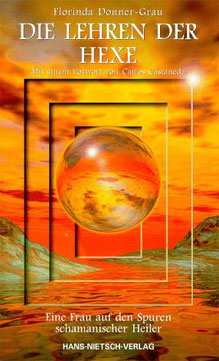
(Transparent bubble. Cover of a German book by Florinda Donner-Grau. Source: http://www.castaneda.witchpage.de/)
Moreover, these bubbles are visually related to living beings: in a burst (!) bubble, CC sees a friend of him, some other time he sees DJ’s friend and seer Genaro appearing out of a bubble (Castaneda, 1974). These perceptions match the concept of the bubbles which is drawn up for the first time in “Tales Of Power†in the context of the “explanation of the sorcerersâ€: human beings are living in bubbles which have closed due to our socialization and which must be opened again from inside (by ourselves) or from outside (by the benefactor) in order to recognize the totality of ourselves and attain ultimate freedom. This concept is continuously developed and, speaking of theoretical complexity, reaches its peak in the seventh book, “The Fire From Withinâ€. The concept “bubble†then is gradually replaced by “luminous eggs†or “cocoonsâ€, modifying also the notion of the shape: while in the early and middle books we read mainly about circular visual objects, the same objects are described rather longish later.
3) Luminous eggs and cocoons
Already in “A Separate Realityâ€, the form of human beings as it is seen by the seers is described as an “egg of circulating fibersâ€. However, this concept is mentioned only briefly and not further elaborated until the fifth book, “The Second Ring Of Powerâ€. Here, the sorceress Gorda explains that only average people look like eggs while sorcerers have the shape of tombstones, round at both ends (Castaneda, 1977). In later books, however, there is no insistence on this difference; rather, these visual objects are simply called “eggs†and later “cocoonsâ€.
Nevertheless, the descriptions of these eggs or cocoons vary: in the sixth book, “The Eagle’s Giftâ€, CC describes these eggs that “moved in a floating manner†as having an external, darker shell and an inner yellowish shining core (Castaneda, 1981). In this and other books, though, we learn that the luminous eggs or cocoons show dark spots, dents or a black hole in their middle, a reference to energy loss which arises from the procreation of children (Castaneda, 1977; 1981; 1984). Both descriptions apply to eye floaters: the concentric luminous floater spheres, too, are verifiably of two types, one having a dark shell and a bright core, the other a luminous shell and a dark core.
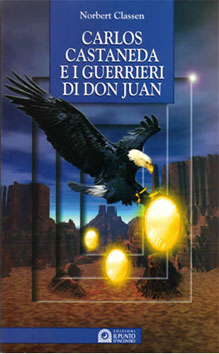
Human beings as luminous eggs. Cover of the Italian translation of Norbert Classen’s book on CC. Source: http://www.carloscastaneda.it/Libri-Castaneda/Norbert-Classen-Carlos-Castaneda-e-i-Guerrieri-di-don-Juan.htm
Starting with the seventh book, “The Fire From Withinâ€, however, the idea of the luminous and dented cocoons takes on such a complexity that the comparison with eye floaters is difficult again: the cocoons consist of a variety of fibers (see below) and do not simply enclose a core but a bundle of bands, called the “Eagle’s emanationsâ€. Next to the spots, holes or dents already mentioned, there is a gap in this cocoon; after DJ, death, as a “rolling forceâ€, would come through this gap and break open the cocoon. This force is also called “tumbler†and is described as approaching balls of fire (Castaneda, 1984) – which, in turn, could be another vision inspired by the perception of eye floaters in intense consciousness states.
DJ explains that this cocoon shows a bright spot or point in the upper area and on the surface, the “assemblage pointâ€, mentioned and elaborated only from the seventh book on. This point groups a number of emanation bands while shifting within the bounds of these emanations, causing and determining man’s perception of the world. Due to our integration into society it is fixed but can be released by appropriate practices and shifted inside the cocoon to allow the perception of completely different worlds (Castaneda, 1984).
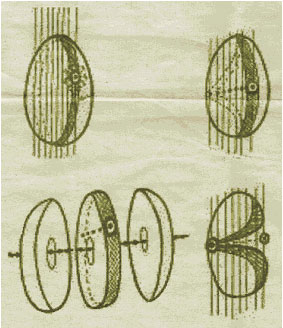
Cocoon with assemblage point. Source: http://www.carloscastaneda.it/Visione-Tolteca.htm
How could the assemblage point be related to eye floaters? One could describe that point as a brighter core on or in a darker cocoon – that is one of the two kinds of eye floater spheres; and there is a corresponding and rare perception of floater spheres in states of deep concentration (of the observer and the sphere) where the core seems to be pushed to the periphery of the sphere. However, the elaborated concept of the assemblage point with its qualities and functions in relation to perception and manipulation can hardly be brought into harmony with the luminous spheres of eye floaters (Tausin, 2009; 2007b).
4) The lines of the world
The “lines of the world†are for the first time discussed in the third book, “Journey To Ixtlanâ€. DJ explains that these lines come out of various parts of our body, the most durable lines come from the middle of the body; they connect us with the world, and one can feel them. “Not-doing†is the practice to feel the world through these lines. A little later, CC perceives the lines while looking into the sun over the horizon. In principle, the “lines of the world†could point to the strings of eye floaters that are seen best and become luminous in bright light conditions and in a concentrated state of mind. However, it is said one can act upon someone using these lines, and in “Tales Of Powerâ€, the descriptions of physical shiftings by means of these lines start (Castaneda, 1972; 1974). Moreover, the term of the “linesâ€, like that of the “bubbleâ€, is not constant: in later books, it is replaced by the terms “filamentsâ€, “strings†and “fibersâ€.
5) Filaments, strings, fibers, and tentacles
The perception of filaments, strings and fibers is a continuous topic with CC. These filaments are described as being luminous and vibrating. In most cases, the fibers are connected with the perception of a human being as a luminous egg or cocoon: the luminous egg of man consists of these fibers, and the fibers come out of the middle of the body or the egg, respectively. On the other hand, these fibers may appear independently of the perception of the luminous balls or eggs, for example in “Journey To Ixtlan†where CC views a mountain range as an array of light fibers, or when CC is told that the whole cosmos consists of these fibers and that we are connected to everything by them (Castaneda, 1972).
“Filament†and “string†are used equivalently; so is “fiber†and “filamentâ€/“stringsâ€, until the relationship between the two is clarified and the concepts expanded in “The Eagle’s Gift†and “The Fire From Withinâ€: here, a string is a thin fiber while a thick fiber is described as a “tentacleâ€. As is the case with “linesâ€, sorcerers are thought to gain information about a person or to manipulate or cure a person by leaving their fibers in him or her during interaction. Also, these fibers serve for the paranormal shifting: by means of them, a sorcerer can grip anything in the area and drag himself to that spot; doing this, he or she overcomes gravity and is able to fly physically.
The reference to the eye floater strings is vague, because, on the one hand, they are described merely as shining and vibrating, and, on the other hand, because of their fanciful shifting function that goes far beyond the bare seeing.
6) The bands of emanations
In “The Fire From Withinâ€, finally, DJ introduces the “great bands of emanationsâ€, a visual experience that integrates all of the main visual objects so far: these bands of emanations are understood as the clusters of the emanations of the Eagle, the power that governs the destiny of all living beings. There are 48 of these bands, but only one is said to produce organic beings:
For instance, there is an immeasurable cluster that produces organic beings. The emanations of that organic band have a sort of fluffiness. They are transparent and have a unique light of their own, a peculiar energy. They are aware, they jump. That’s the reason why all organic beings are filled with a peculiar consuming energy. The other bands are darker, less fluffy. Some of them have no light at all, but a quality of opaqueness. … Think of it as an enormously wide band of luminous filaments, luminous strings with no end. Organic beings are bubbles that grow around a group of luminous filaments (Castaneda, 1984).
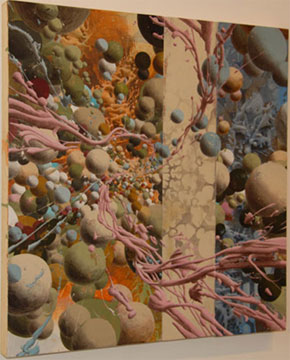
Band of Emanations? Painting by Mars-1 (Mario Martinez), exhibited at White Walls (Tenderloin, SF), showing “Mescalito†in 2006 . Source: http://www.fecalface.com/SF/index.php?option=com_content&task=view&id=367&Itemid=90
This visual experience of the seers has much in common with the perception of eye floaters in intense consciousness states: floaters are seen to belong to several layers; strings and spheres (bubbles) look transparent or luminous, blurred or focused, dependent on the ability of concentration; spheres are inside or around the strings; they don’t float anymore but jump (viz. the consciousness light illuminates different strings and bubbles) (Tausin, 2009; 2007b).
Conclusions
In CC’s books, there is no explicit indication that the extraordinary perceptions of subjective visual phenomena are, in fact, eye floaters. However, we find a partial correspondence of CC’s descriptions of such phenomena with the reports of the Swiss seers of the Emmental on the visual experience of eye floaters in various states of consciousness, my own visual experience included (Tausin, 2009; 2007b). The bubbles, the balls of fire, the luminous eggs and the cocoons can absolutely be understood as the luminous dots or spheres of floaters, while the energy lines, filaments, fibers and tentacles point to the luminous floater strings. However, the comparison of CC’s visual phenomena with eye floaters is made difficult by the fact that the meanings and descriptions of the phenomena mentioned are not constant but change through the books of CC: the appearance and function of the round and string-like objects become increasingly complex and detailed.
In my opinion, it is nevertheless not only possible but very likely that CC knew the phenomenon of eye floaters, and that they had an inspiring effect on his work, for two reasons: first, eye floaters are known to the people around CC, as was shown in the interview of the Chacmool women. Second, it is hardly conceivable to me that someone who enters intensive consciousness states for many years to explore very attentively the most subtle visual phenomena never gets a glimpse of these dots and strings of eye floaters. The connection of consciousness and eye floaters may not be recognized in the beginning; but over the years and after careful examinations of the visual phenomena in relation to the extraordinary consciousness states, the observer will, in my opinion, recognize the deeper meaning of eye floaters.
Whether CC was that observer is, in turn, another question. And that brings us to the crucial question: if CC’s work is actually inspired by eye floaters, as I assume, why don’t we find that clearly stated in any of his books? The following scenarios are conceivable:
1) CC couldn’t see eye floaters and knew nothing about them. In this case it would have been DJ (or whoever was his informant and teacher) who reported about his extraordinary visual perceptions of luminous balls and strings – and perhaps embroidered these reports himself. If that person was actually a Mexican Indian without access to Western academic knowledge, it can be assumed that he did not know about the ophthalmologic explanation of eye floaters.
2) CC couldn’t see eye floaters but let himself inspire by pre-Columbian Native American art. This art often consists of geometric ornamentations (e.g. spheres and strings) and in many cases is a depiction of entoptic phenomena (e.g. eye floaters) perceived by shamans during their visionary experiences (Tausin, 2006b; 2007a; Thurston, 1991). In both of these cases, modern medical explanations and studies on entoptic phenomena and shamanistic art, starting in the late 1980s, would have never been subject of the conversations between CC and DJ.
3) CC has seen the eye floaters and maybe even recognized their deeper meaning due to his consciousness altering practices. In his books, however, he transfigured his perceptions very strongly, referring to Native American shamanistic mythology. Perhaps CC even knew the medical explanation of that entoptic phenomenon from the beginning. However, there was no point in providing that medical or ophthalmological approach in his books, for, on the one hand, his audience was looking for the fantastic and spiritual aspects of reality, not the academic ones; and on the other hand, his work would have become a pathological dimension in a time when many anthropologists were still doubting the sanity of shamans in general.
Anyway: CC’s work not only demands a great deal of tolerance and imagination by its elaborated descriptions of altered states of consciousness, but also opens up a big range of interpretation by its theoretical and conceptual expansions and complexity – an interpretation range in which eye floaters fit with a high degree of probability. Symptomatic for this is a particular situation in “The Fire From Within†where DJ interprets CC’s perception of the balls of fire in more detail: out of these balls of fire, he said, there “comes an iridescent hoop exactly the size of living beings, whether men, trees, microbes or alliesâ€. When CC asks about the possibility of different-sized circles, DJ protests: “Don’t take me so literally.”
References:
The pictures are taken from image hosting websites, from scientific publications (online and print) and/or from my own collection (FT). Either they are licensed under a Creative Commons license, or their copyright is expired, or they are used according to the copyright law doctrine of ‘Zitatrecht’, ‘fair dealing’ or ‘fair use’.
Castaneda, Carlos. (1968). The Teachings of Don Juan. A Yaqui Way of Knowledge. University of California Press
Castaneda, Carlos. (1971). A Separate Reality. Further Conversations with Don Juan. New York: Simon & Schuster
Castaneda, Carlos. (1972). Journey to Ixtlan. The Lessons of Don Juan. New York: Simon & Schuster
Castaneda, Carlos. (1974). Tales of Power. New York: Simon & Schuster
Castaneda, Carlos. (1977). The Second Ring of Power. New York: Simon & Schuster
Castaneda, Carlos. (1981). The Eagle’s Gift. New York: Simon & Schuster
Castaneda, Carlos. (1984). The Fire From Within. New York: Simon & Schuster
Castaneda, Carlos. (1987). The Power of Silence. Further Lessons of Don Juan. New York: Simon & Schuster
Castaneda, Carlos. (1993). The Art of Dreaming. New York: Haper Collins
Castaneda, Carlos. (1997). The Active Side of Infinity. New York: Harper Collins
Donovan, Corey. (2007). Carol Tiggs. Chronolog Part IV (1994-May 1995). Sustained Action. http://sustainedaction.org/Chronologies/chronTiggsIV.htm (8.2.10)
Lewis-Williams, J. D.; Dowson, T. A. (1988). The Signs of All Times. Current Anthropology, vol. 29, nr. 2, April
Murray, Stephen O.. (1979). The Scientific Reception of Castaneda, in: Contemporary Sociology 8, 2: 189-192
Tausin, Floco. (2009a). Mouches Volantes. Eye Floaters as Shining Structure of Consciousness. Bern: Leuchtstruktur Verlag
Tausin, Floco. (2009b). “Open Eye Meditation. The visual way to the development of the inner sense”. The International Journal of Healing and Caring (IJHC) 9, 3. http://www.wholistichealingresearch.com/ijhchome (28.8.09)
Tausin, Floco. (2007a). “Entoptic Art – Entoptische Erscheinungen als Inspirationsquelle in der zeitgenössischen bildenden Kunst”. Extremnews. http://www.extremnews.com/berichte/vermischtes/396b116f79905e4 (29.1.07)
Tausin, Floco. (2007b). Mouches volantes. Bewegliche Kugeln und Fäden aus der Sicht eines Sehers. Jenseits des Irdischen 2
Tausin, Floco. (2006a). “Zwischen Innenwelt und Aussenwelt. Entoptische Phänomene und ihre Bedeutung für Bewusstseinsentwicklung und Spiritualität”. Schlangentanz 3
n/a. (1995). A New Generation Of Sorcerers. Kindred Spirit 1. http://www.oldnagualnet.com/wtg/INTERVIEWS/KINDRED1.HTML
Tausin, Floco. (2006b). “Mouches volantes und Trance. Ein universelles Phänomen bei erweiterten Bewusstseinszuständen früher und heute”. Jenseits des Irdischen 3
Tausin, Floco. (2006c). “Mouches volantes. Bewegliche Kugeln und Fäden aus der Sicht eines Sehers”. Q’Phaze. Realität … Anders! 4
Thurston, Linda. (1991). Entoptic Imagery in People and Their Art, (MA thesis). http://home.comcast.net/~markk2000/thurston/thesis.html (11.2.10)
The author:
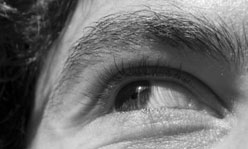 The name Floco Tausin is a pseudonym. The author is a graduate of the Faculty of the Humanities at the University of Bern, Switzerland. In theory and practice he is engaged in the research of subjective visual phenomena in connection with altered states of consciousness and the development of consciousness. In 2009, he published the mystical story “Mouches Volantes†about the spiritual dimension of eye floaters.
The name Floco Tausin is a pseudonym. The author is a graduate of the Faculty of the Humanities at the University of Bern, Switzerland. In theory and practice he is engaged in the research of subjective visual phenomena in connection with altered states of consciousness and the development of consciousness. In 2009, he published the mystical story “Mouches Volantes†about the spiritual dimension of eye floaters.
The book:
‚Mouches Volantes. Eye Floaters as Shining Structure of Consciousness‘.
(Spiritual Fiction. ISBN: 978-3033003378. Paperback, 15.2 x 22.9 cm / 6 x 9 inches, 368 pages).
Floco Tausin tells the story about his time of learning with spiritual teacher and seer Nestor, taking place in the hilly region of Emmental, Switzerland. The mystic teachings focus on the widely known but underestimated dots and strands floating in our field of vision, known as eye floaters or mouches volantes. Whereas in ophthalmology, floaters are considered a harmless vitreous opacity, the author gradually learns about them to see and reveals the first emergence of the shining structure formed by our consciousness.
»Mouches Volantes« explores the topic of eye floaters in a much wider sense than the usual medical explanations. It merges scientific research, esoteric philosophy and practical consciousness development, and observes the spiritual meaning and everyday life implications of these dots and strands.
»Mouches Volantes« – a mystical story about the closest thing in the world.
